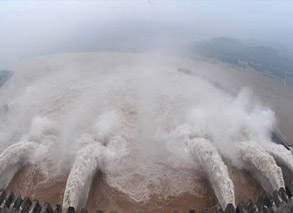Hibiscus Town: A Tujia ethnic minority village
2009-09-11 16:48 BJTSpecial Report: Walking into Ethnic Minorities |
The original name of Hibiscus Town is Wang Cun, or Wang Village - an ordinary name by all accounts.
 |
| Hibiscus Town |
But in 1986, a movie was shot in the village located in the southwestern part of central China's Hunan Province, and as a result of the sensation the movie created, Wang Village has become a household name among the Chinese.
In 1997, Wang Village officially changed its name to Hibiscus Town, adopting the name of the village in the movie.
Now, Hibiscus Town is a popular tourist destination for travelers who come here to see the place where the movie was filmed. But as soon as they arrive, they find there is much more to see.
"There are three things for tourists to experience in Hibiscus Town," said Tang Hui, the town's deputy head. "One is the filming sites from the movie; another is the well-preserved Tujia ethnic culture. There's another aspect of the town that most people neglect-it is an ancient town with more than two thousand years of history."
The movie "Hibiscus Town" was filmed here for seven and a half months, and nearly every villager participated in its making either as service personnel or movie extras.
Xiang Naiwen, a 50-year old resident was one of the extras who played a vendor selling handicrafts on the street. Like other villagers, he can recall some anecdotes about the film crew. For instance, Jiang Wen, the movie's leading actor, would run around the villages in the morning to build up his physique, which was required in the movie, Xiang said.
Xiang is now the head of a factory that produces Tujia brocade, a very popular souvenir in Hibiscus Town where 85 percent of the village's residents are members of the Tujia ethnic minority group.
Tujia culture is well-preserved in Hibiscus Town. "Mao Goose," an ancient Tujia dance, was performed at the opening ceremony of the 2008 Beijing Olympics. It requires dozens of dancers and describes the daily activities of ancient Tujia such as hunting, fishing and farming.
Hibiscus Town holds a festival every year featuring Tujia dances. The "Hand-waving Dance" is one of the favorite dances of the Tujia people. It usually lasts seven or eight days and is performed at the beginning or end of a year to pray for good luck.
Besides Tujia traditions, Hibiscus Town is home to many historic artifacts. The Xizhou copper pillar, some four meters tall and weighing 2,500 kilograms, dates back to the Warring States Period(475-221 BC). At the time, it served as a war covenant made between an emperor of the Chu State, one of the three Warring States of the time, and the local ruler, but now it is an important object for studying national relations in ancient China. It is displayed in the town's Exhibition.
Crouching along the bank of Youshui River, Hibiscus Town used to be a prosperous harbor connecting villages in the region to the outside world. Although with the emergence of land transportation, businessman gradually abandoned the water route, and the spirit of commerce was perfectly transformed.
Tourism is considered to hold the greatest potential for modern Hibiscus Town.
"We are working on improving the service sector in the tourism industry and more importantly, extending the focus from the movie to Tujia ethnic culture, historical heritages and all the other things we have to offer," Tang Hui said.

 Mail
Mail Share
Share Print
Print


 Video
Video









 2009 China Central Television. All Rights Reserved
2009 China Central Television. All Rights Reserved